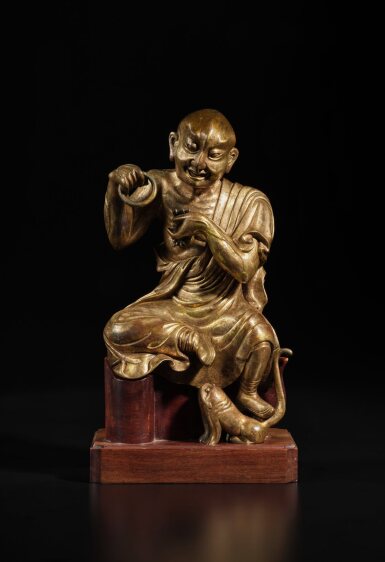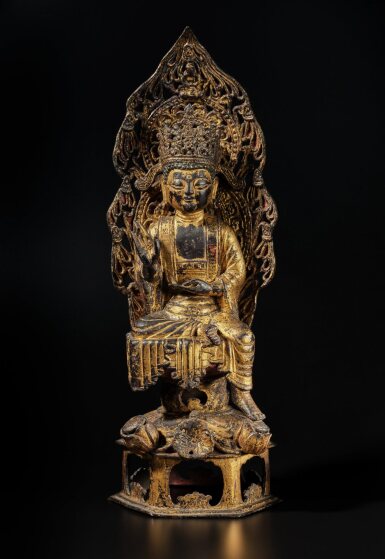DescriptionA gilt-bronze figure of KasyapaLiao Dynasty遼 銅鎏金迦葉尊者坐像
wood stand (2)
Height 9½ in., 24 cmCondition reportGood condition, with just minor rubbing to the gilding. There is minor scratching and general surface wear.
For more information on and additional videos for this lot, please contact Eleanor.Jahrling@sothebys.com.
Because this lot was imported into the United States after September 1, 2020, it is subject to an import tariff of 7.5% of the value declared upon entry into the United States. $52,500.00, plus applicable sales tax will be included on your invoice unless you instruct Sotheby's to arrange shipping of the lot to a foreign address. For more information on the import tariff, please review the Symbol Key in the back of the catalogue. If you have any questions, please contact tariffs@sothebys.com. 由於本拍品在 2020年9月1日之後進口到美國,所以買家可能需就本拍品支付進口關稅,金額為拍品進口美國當時申報價值的7.5%。除非您要求蘇富比安排運送拍品到美國境外之地址,否則發票上將包括 52,500.00 美元以及相關的銷售稅。如欲查詢進口關稅的更多信息,請查閱目錄背面的附錄。如有任何疑問,敬請聯繫tariffs@sothebys.com。
In response to your inquiry, we are pleased to provide you with a general report of the condition of the property described above. Since we are not professional conservators or restorers, we urge you to consult with a restorer or conservator of your choice who will be better able to provide a detailed, professional report. Prospective buyers should inspect each lot to satisfy themselves as to condition and must understand that any statement made by Sotheby's is merely a subjective qualified opinion.NOTWITHSTANDING THIS REPORT OR ANY DISCUSSIONS CONCERNING CONDITION OF A LOT, ALL LOTS ARE OFFERED AND SOLD "AS IS" IN ACCORDANCE WITH THE CONDITIONS OF SALE PRINTED IN THE CATALOGUE.
我們很高興為您提供上述拍品狀況報告。由於敝公司非專業修復人員,在此敦促您徵詢其他專業修復人員,以獲得更詳盡、專業之報告。
準買家應該檢查每件拍品以確認其狀況,蘇富比所作的任何陳述均為主觀看法而非事實陳述。雖然本狀況報告或有針對某拍品之討論,但所有拍賣品均根據印於圖錄內之業務規則以拍賣時狀況出售。ProvenanceMichael C. Hughes, New York.
Michael C. Hughes, 紐約Catalogue noteThis sensitively cast and brilliantly gilded sculpture appears to be the earliest surviving Chinese representation of a luohan in bronze. Other Liao dynasty gilt-bronze figures of this large size are recorded in private and museum collections, primarily of bodhisattvas, but no other luohan appears to be published.
For a dried-lacquer figure of a luohan, dated 1099, preserved in the Honolulu Academy of Arts, Honolulu, see Marilyn Leidig Gridley, Chinese Buddhist Sculpture Under The Liao: Free Standing Works In Situ and Selected Examples From Public Collections, New Delhi, 1993, fig. 97. The close similarity of the depiction of the current gilt-bronze luohan and the Honolulu dried-lacquer luohan, with their identical seated positions, mudras, facial expressions, and even the manner in which the ends of the robe fold out, strongly suggests they were made around the same time. For a stone sculpture of a luohan in an identical seated position, with closely related treatment of the facial features and drapery, see Osvald Sirén, Chinese Sculpture from the Fifth to the Fourteenth Century, Stockholm, 1998, pl. 602. The close similarity of the three figures, though created in various media, suggests they are roughly contemporaneous, based on a popular form at the time.
The almond-shaped eyes of the present figure resemble the eyes of other gilt-bronze figures dated to the Liao period, such as those illustrated in Denise Patry Leidy and Donna Strahan, Wisdom Embodied: Chinese Buddhist and Daoist Sculpture in the Metropolitan Museum of Art, New Haven, 2010, pls 25 and 26. Compare a Liao gilt-bronze figure of Guanyin cast with similar treatment of the facial features, robes and drapery, but of a smaller size, sold in these rooms, 30th March 2006, lot 276. A large sancai-glazed figure of a luohan in a similar pose attributed to the Liao dynasty is in the collection of the British Museum, London, and illustrated in Hai-Wai Yi-Chen: Chinese Art in Overseas Collections, Buddhist Sculpture I, Taipei, 1998, pls 151 and 152.
A luohan is a perfected being, a disciple of Buddha who has attained enlightenment, but chooses to remain engaged in the world, postponing nirvana, in order to aid all sentient beings. The distinctive facial features of the present disciple, with his high cheekbones, prominent nose and wrinkled forehead indicate that this luohan is elderly, and appears to represent Kasyapa, who was one of Shakyamuni Buddha's ten principal disciples. Kasyapa came from the kingdom of Magadha and by the time he met Buddha, was already well into his eighties. He was a renowned ascetic and had a large following of his own.
In the Chan Buddhist tradition, Kasyapa is considered the first Indian patriarch and Ananda, the second. They are often portrayed together on either side of Buddha. This arrangement is commonly found in caves in China dating from the Northern Wei dynasty (386-535), with Ananda to Buddha's right and Kasyapa to the left, as seen in the Central Binyang Cave at Longmen, illustrated in Angela Falco Howard et. al., Chinese Sculpture, New Haven, 2006, pl. 3.39. This standard iconographic arrangement continued through the Sui, Tang, Liao and Song periods, all the way to the Ming dynasty.
The dating of this lot is consistent with the results of a thermoluminescence test, Ciram Sarl., certificate 0310-OA-79R-1, where the age of its last heating is concluded as being circa 1000-1050.
此坐像鎏金厚重,刻畫出神。公私收藏中可見尺寸相近之遼代佛像,但多為菩薩,著錄未見有其他羅漢例,可見本尊應為傳世中國羅漢造像先例。
檀香山藝術博物館藏一乾漆羅漢像,紀年西夏晚期永安五年(1099年),見 Marilyn Leidig Gridley,《Chinese Buddhist Sculpture Under The Liao: Free Standing Works In Situ And Selected Examples From Public Collections》,The International Academy of Indian Culture and Aditya Prakashan,新德里,1993年,圖97。檀香山羅漢例之坐姿、手印、面相、衣褶,皆與本尊極為接近,應屬同代。另有一石雕羅漢,無論坐姿、輪廓、衣褶,均與此類同,宜作對比,見 Osvald Siren,《Chinese Sculpture from the Fifth to the Fourteenth Century》,斯德哥爾摩,1998年,圖版602。材質雖異,三者甚為相似,可推斷年代相約,且以當朝風格為據。
此像杏圓形眼,近似其他遼代銅鎏金佛,例見 Denise Patry Leidy 及 Donna Strahan,《Wisdom Embodied: Chinese Buddhist and Daoist Sculpture in the Metropolitan Museum of Art》,紐黑文,2010年,編號25及26。另有一例,售於紐約蘇富比2006年3月30日,編號276。亦見一遼代三彩羅漢像,形態相若,藏於大英博物館,載於《海外遺珍.佛像一》,台北,1998年,圖版151及152。
羅漢,為佛陀得道弟子,皆了脫生死,證入涅盤。於壽命未盡前,仍住世間,梵行少欲,戒德清淨,隨緣教化度眾。此羅漢面相獨特,高顴骨,隆鼻,前額皺起,可知其年長,本像或為迦葉佛,是釋迦牟尼十大弟子之一,來自摩揭陀國,見佛祖時,年已八旬,其少欲知足,常修苦行,受眾人膜拜。
禪宗一脈,視迦葉尊者為初祖,阿難尊者繼二祖,二者常侍佛陀兩側,此組合普見於北魏石雕,阿難位右,迦葉居左,例見於龍門石窟賓陽中洞,錄於 Angela Falco Howard、李松、巫鴻及楊泓,《中國古代雕塑》,紐黑文,2006年,頁238,圖3.39。此組合方式,後歷經隋、唐、遼、宋,襲至明朝。
此拍品經熱釋光測定,結果與斷代吻合,斷代約1000至1050年(西林檢驗所,測試編號:0310-OA-79R-1)
DescriptionA gilt-bronze figure of KasyapaLiao Dynasty遼 銅鎏金迦葉尊者坐像
wood stand (2)
Height 9½ in., 24 cmCondition reportGood condition, with just minor rubbing to the gilding. There is minor scratching and general surface wear.
For more information on and additional videos for this lot, please contact Eleanor.Jahrling@sothebys.com.
Because this lot was imported into the United States after September 1, 2020, it is subject to an import tariff of 7.5% of the value declared upon entry into the United States. $52,500.00, plus applicable sales tax will be included on your invoice unless you instruct Sotheby's to arrange shipping of the lot to a foreign address. For more information on the import tariff, please review the Symbol Key in the back of the catalogue. If you have any questions, please contact tariffs@sothebys.com. 由於本拍品在 2020年9月1日之後進口到美國,所以買家可能需就本拍品支付進口關稅,金額為拍品進口美國當時申報價值的7.5%。除非您要求蘇富比安排運送拍品到美國境外之地址,否則發票上將包括 52,500.00 美元以及相關的銷售稅。如欲查詢進口關稅的更多信息,請查閱目錄背面的附錄。如有任何疑問,敬請聯繫tariffs@sothebys.com。
In response to your inquiry, we are pleased to provide you with a general report of the condition of the property described above. Since we are not professional conservators or restorers, we urge you to consult with a restorer or conservator of your choice who will be better able to provide a detailed, professional report. Prospective buyers should inspect each lot to satisfy themselves as to condition and must understand that any statement made by Sotheby's is merely a subjective qualified opinion.NOTWITHSTANDING THIS REPORT OR ANY DISCUSSIONS CONCERNING CONDITION OF A LOT, ALL LOTS ARE OFFERED AND SOLD "AS IS" IN ACCORDANCE WITH THE CONDITIONS OF SALE PRINTED IN THE CATALOGUE.
我們很高興為您提供上述拍品狀況報告。由於敝公司非專業修復人員,在此敦促您徵詢其他專業修復人員,以獲得更詳盡、專業之報告。
準買家應該檢查每件拍品以確認其狀況,蘇富比所作的任何陳述均為主觀看法而非事實陳述。雖然本狀況報告或有針對某拍品之討論,但所有拍賣品均根據印於圖錄內之業務規則以拍賣時狀況出售。ProvenanceMichael C. Hughes, New York.
Michael C. Hughes, 紐約Catalogue noteThis sensitively cast and brilliantly gilded sculpture appears to be the earliest surviving Chinese representation of a luohan in bronze. Other Liao dynasty gilt-bronze figures of this large size are recorded in private and museum collections, primarily of bodhisattvas, but no other luohan appears to be published.
For a dried-lacquer figure of a luohan, dated 1099, preserved in the Honolulu Academy of Arts, Honolulu, see Marilyn Leidig Gridley, Chinese Buddhist Sculpture Under The Liao: Free Standing Works In Situ and Selected Examples From Public Collections, New Delhi, 1993, fig. 97. The close similarity of the depiction of the current gilt-bronze luohan and the Honolulu dried-lacquer luohan, with their identical seated positions, mudras, facial expressions, and even the manner in which the ends of the robe fold out, strongly suggests they were made around the same time. For a stone sculpture of a luohan in an identical seated position, with closely related treatment of the facial features and drapery, see Osvald Sirén, Chinese Sculpture from the Fifth to the Fourteenth Century, Stockholm, 1998, pl. 602. The close similarity of the three figures, though created in various media, suggests they are roughly contemporaneous, based on a popular form at the time.
The almond-shaped eyes of the present figure resemble the eyes of other gilt-bronze figures dated to the Liao period, such as those illustrated in Denise Patry Leidy and Donna Strahan, Wisdom Embodied: Chinese Buddhist and Daoist Sculpture in the Metropolitan Museum of Art, New Haven, 2010, pls 25 and 26. Compare a Liao gilt-bronze figure of Guanyin cast with similar treatment of the facial features, robes and drapery, but of a smaller size, sold in these rooms, 30th March 2006, lot 276. A large sancai-glazed figure of a luohan in a similar pose attributed to the Liao dynasty is in the collection of the British Museum, London, and illustrated in Hai-Wai Yi-Chen: Chinese Art in Overseas Collections, Buddhist Sculpture I, Taipei, 1998, pls 151 and 152.
A luohan is a perfected being, a disciple of Buddha who has attained enlightenment, but chooses to remain engaged in the world, postponing nirvana, in order to aid all sentient beings. The distinctive facial features of the present disciple, with his high cheekbones, prominent nose and wrinkled forehead indicate that this luohan is elderly, and appears to represent Kasyapa, who was one of Shakyamuni Buddha's ten principal disciples. Kasyapa came from the kingdom of Magadha and by the time he met Buddha, was already well into his eighties. He was a renowned ascetic and had a large following of his own.
In the Chan Buddhist tradition, Kasyapa is considered the first Indian patriarch and Ananda, the second. They are often portrayed together on either side of Buddha. This arrangement is commonly found in caves in China dating from the Northern Wei dynasty (386-535), with Ananda to Buddha's right and Kasyapa to the left, as seen in the Central Binyang Cave at Longmen, illustrated in Angela Falco Howard et. al., Chinese Sculpture, New Haven, 2006, pl. 3.39. This standard iconographic arrangement continued through the Sui, Tang, Liao and Song periods, all the way to the Ming dynasty.
The dating of this lot is consistent with the results of a thermoluminescence test, Ciram Sarl., certificate 0310-OA-79R-1, where the age of its last heating is concluded as being circa 1000-1050.
此坐像鎏金厚重,刻畫出神。公私收藏中可見尺寸相近之遼代佛像,但多為菩薩,著錄未見有其他羅漢例,可見本尊應為傳世中國羅漢造像先例。
檀香山藝術博物館藏一乾漆羅漢像,紀年西夏晚期永安五年(1099年),見 Marilyn Leidig Gridley,《Chinese Buddhist Sculpture Under The Liao: Free Standing Works In Situ And Selected Examples From Public Collections》,The International Academy of Indian Culture and Aditya Prakashan,新德里,1993年,圖97。檀香山羅漢例之坐姿、手印、面相、衣褶,皆與本尊極為接近,應屬同代。另有一石雕羅漢,無論坐姿、輪廓、衣褶,均與此類同,宜作對比,見 Osvald Siren,《Chinese Sculpture from the Fifth to the Fourteenth Century》,斯德哥爾摩,1998年,圖版602。材質雖異,三者甚為相似,可推斷年代相約,且以當朝風格為據。
此像杏圓形眼,近似其他遼代銅鎏金佛,例見 Denise Patry Leidy 及 Donna Strahan,《Wisdom Embodied: Chinese Buddhist and Daoist Sculpture in the Metropolitan Museum of Art》,紐黑文,2010年,編號25及26。另有一例,售於紐約蘇富比2006年3月30日,編號276。亦見一遼代三彩羅漢像,形態相若,藏於大英博物館,載於《海外遺珍.佛像一》,台北,1998年,圖版151及152。
羅漢,為佛陀得道弟子,皆了脫生死,證入涅盤。於壽命未盡前,仍住世間,梵行少欲,戒德清淨,隨緣教化度眾。此羅漢面相獨特,高顴骨,隆鼻,前額皺起,可知其年長,本像或為迦葉佛,是釋迦牟尼十大弟子之一,來自摩揭陀國,見佛祖時,年已八旬,其少欲知足,常修苦行,受眾人膜拜。
禪宗一脈,視迦葉尊者為初祖,阿難尊者繼二祖,二者常侍佛陀兩側,此組合普見於北魏石雕,阿難位右,迦葉居左,例見於龍門石窟賓陽中洞,錄於 Angela Falco Howard、李松、巫鴻及楊泓,《中國古代雕塑》,紐黑文,2006年,頁238,圖3.39。此組合方式,後歷經隋、唐、遼、宋,襲至明朝。
此拍品經熱釋光測定,結果與斷代吻合,斷代約1000至1050年(西林檢驗所,測試編號:0310-OA-79R-1)















Try LotSearch and its premium features for 7 days - without any costs!
Be notified automatically about new items in upcoming auctions.
Create an alert